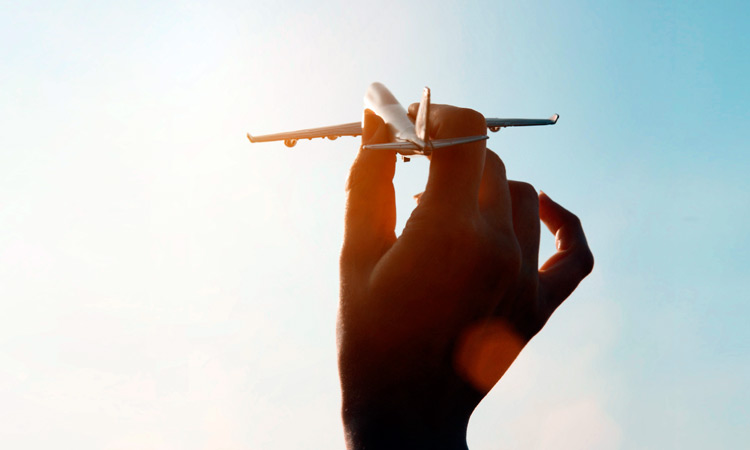 For many, an airline flight can be an uneasy or even daunting part of traveling. By planning ahead and following these six tips, you will enjoy a more restful journey.
For many, an airline flight can be an uneasy or even daunting part of traveling. By planning ahead and following these six tips, you will enjoy a more restful journey.
1. Breathe through pre-flight anxiety
Many travelers experience flight anxiety long before they board the airplane. At this stage, deep breathing and meditation can provide relief for anxiety, by taking your focus inward. Inhale deeply through the nose, and release a big sigh out your mouth. Breathe in and out of your nose slowly, filling the belly with air. Scan your body for tension, releasing it as you exhale. Feel your body grow lighter.
2. Pack for onboard comfort
Consider earplugs, an eye cover and a blowup pillow for your neck. To avoid back pain, Cornell Professor of ergonomics, Alan Hedge, PhD, CPE, recommends forming a support for each side of your back by rolling a pillow, jacket or a blanket. Hedge also endorses a small seat orthotic, the BackJoy.
3. Wear loose clothing for mobility
Tight clothes can cause leg and foot swelling, and discomfort. If you are at high-risk for travel-related deep vein thrombosis (DVT), a type of blot clot in deep leg veins, the CDC recommends special compression stockings.
According to Dr Sarah Jarvis, some common risk factors include recent operations, pregnancy, a broken leg in plaster, combined oral contraceptives or hormone replacements, obesity or recent severe illnesses. Talk to your doctor before flying if you have any risk factors for DVT.
4. Avoid anxiety during flight
New studies indicate deep breathing techniques may not effectively reduce anxiety while flying because turbulence may undermine your sense of calm and safety by releasing a new batch of stress hormones while you are deeply, internally focused. As an alternative, Captain Tom Bunn, pilot and L.C.S.W., who has spent the last 30 years dedicated to developing treatments for flight phobia, is tapping into the Social Engagement System (SES). Bunn explains:
“[W]hen the chemistry is right between two people, when they look at each other as if they were the only two people in the world, the SES gets involved in the chemistry. It releases oxytocin and vasopressin, peptides that can inhibit the amygdala and make the release of stress hormones impossible. In this way, the SES temporarily shuts the fear system down…”
Bunn suggests that SES can be used to treat travelers with flight anxiety by creating a positive association between a lover’s face and the various steps of flying, such as boarding, takeoff, turbulence, and landing.
5. Get up and move around every half hour
Recent studies show prolonged sitting in our daily lives can lead to cardiovascular disease, cancer, type 2 diabetes and early death. Because long flights also increase the odds for DVT, the CDC recommends you obtain an aisle seat for extra leg-room and free cabin access. The Mayo Clinic also advises staying hydrated, avoiding alcohol or any sedatives that may compromise your ability to move safely about the cabin.
6. Practice yoga in your seat
These yoga poses alleviate stiffness and pain. The starred (*) movements specifically prevent DVT.
a. Shoulder rolls—Sit tall, inhale your shoulders toward your ears. Exhale, circling the shoulders back and down.
b.* Head circles—Inhale tall, then exhale your chin to your chest. Let your head hang heavy and circle it slowly, dropping your shoulders. Pause and breathe into each tight spot. Reverse.
c.* Neck stretches—Inhale tall. Exhale and drop your right ear to your right shoulder, reaching your arms down by your sides. Breathe. Reverse.
d. Open-heart shoulder stretch—Roll your shoulders down and back, squeezing the shoulder blades together and clasp the hands behind you. Lift your hands up, and open your heart.
e. Cat/cow—Hands on your thighs, exhale bringing your navel toward your back and round your spine into a contraction one vertebrae at a time, dropping your head last. Inhale, and reverse into “cow” pose, beginning again with the navel and ending with the head.
f. Seated pigeon—Rest one flexed foot across the opposite thigh. Sit tall, and fold forward without rounding the back, stretching the top hip. Circle the top ankle each way. Switch legs.
g.* Foot Circles and heel toe flexion—Extend one leg just above the floor, circling the ankle in each direction. Point and flex the foot several times. Switch legs.
h.* Shivasana (final relaxation)—Tense all your muscles and then relax them. Let go completely and focus on your breath, settling in for a more comfortable flight.


